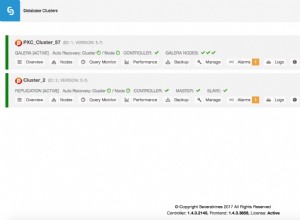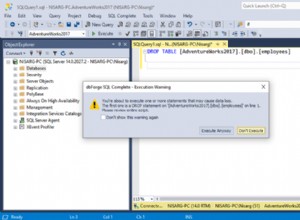Para llamar a la función desde una consulta SQL, debe convertir los parámetros a su tipo personalizado como en el siguiente ejemplo.
select form_insertion(array[
cast(row('Form 1', 1, current_date, 1, current_date, 'This is form 1',
array[
cast(row('section-1', 'Section One', 1) as section),
cast(row('section-2', 'Section Two', 2) as section),
cast(row('section-3', 'Section Three', 3) as section)
]
) as form_details),
cast(row('Form 2', 2, current_date, 1, current_date, 'This is form 2',
array[
cast(row('section-2', 'Section Two', 2) as section),
cast(row('section-3', 'Section Three', 3) as section)
]
) as form_details),
cast(row('Form 3', 1, current_date, 1, current_date, 'This is form 3',
array[
cast(row('section-1', 'Section One', 1) as section),
cast(row('section-3', 'Section Three', 3) as section)
]
) as form_details)
])
Tenga en cuenta que las matrices de PostgreSQL no tienen una propiedad .COUNT. Puede recorrer una matriz por rango de índice con matriz_superior función:
for i IN 1..array_upper(formdetails, 1)
LOOP
-- your code here
END LOOP;
Desde PostgreSQL 9.1, puede usar la declaración FOREACH para recorrer la matriz:
create or replace function form_insertion(formdetails form_details[])
returns varchar as $$
declare
detail form_details;
sec section;
begin
foreach detail in array formdetails
LOOP
RAISE NOTICE '%', detail.formName;
foreach sec in array detail.sections
LOOP
raise NOTICE '%', sec.sectionName;
END LOOP;
END LOOP;
return '';
end;$$
language plpgsql;




